2006 VOLKSWAGEN GOLF MK5 warning light
[x] Cancel search: warning lightPage 102 of 444
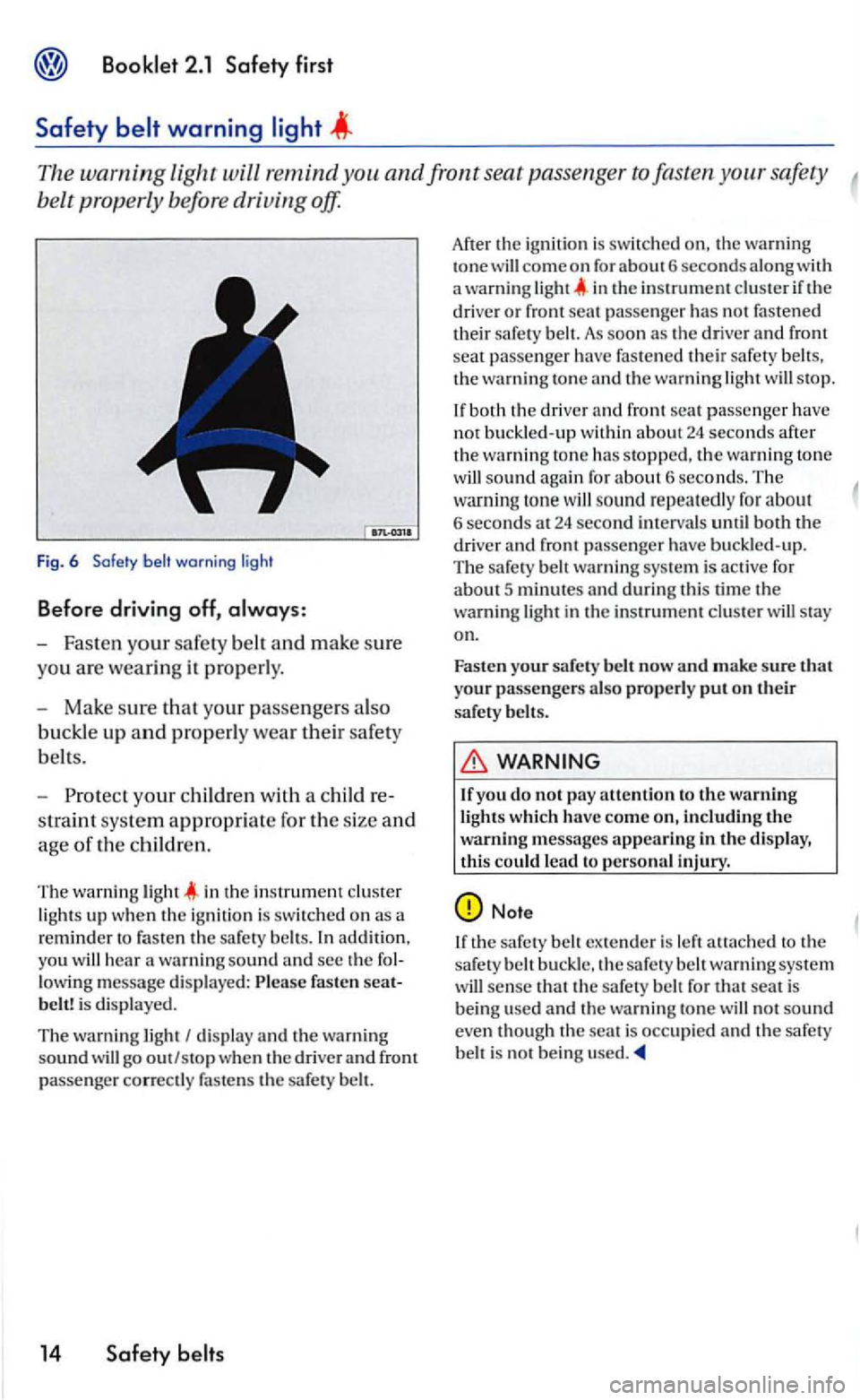
The warning Light will remind safety
belt prop erly before driving off.
Fig . 6 Safety warn in g l ig ht
Before driving off,
-Fast en your safety belt and make sure
you are wea ring it properly.
- Mak e sure that your passengers als o
buckle
up and properly wear their safety
b elts.
- Pro tec t yo
ur children with a child re
s traint sys
tem appropria te for the size and
age of th e children.
T he wa rnin g in the in strument lights up w he n the ig niti on is switched o n as a
reminder to fasten th e safety addition,
yo u
14 Safety
Afte r the ig nition is swit ch ed th e warning tone come on for about6 second s along with warning light in the in strument if th e drive r or front seat passe nge r has not fastened their safet y bel t. As soon as the driver and front seat passe nger have fastened their safety the wa rnin g ton e and the warning light stop .
sound aga in for about 6 second s. The
ton e w ill sound repeatedly for about 6 seconds 24 second interva ls until both drive r and front passenger have buckled-up .
T he safety wa rnin g system is active for about 5 minutes and during thi s time the warni ng light in the instrument clus te r wiU stay
on.
Fa s
ten your safe ty belt now and make sure t hat your passengers also properly put o n their
safery belts.
WARNING
If yo u do not pay attenti on to the warning
li ghts whic h h ave come including the warning messages appearing in the display, this could lead to pe rsonal injury.
ex tender is left attac h ed to the
s afery warning sys tem will sense th at th e safe ty n o t sound even though th e is occ upie d and the safery
Page 107 of 444
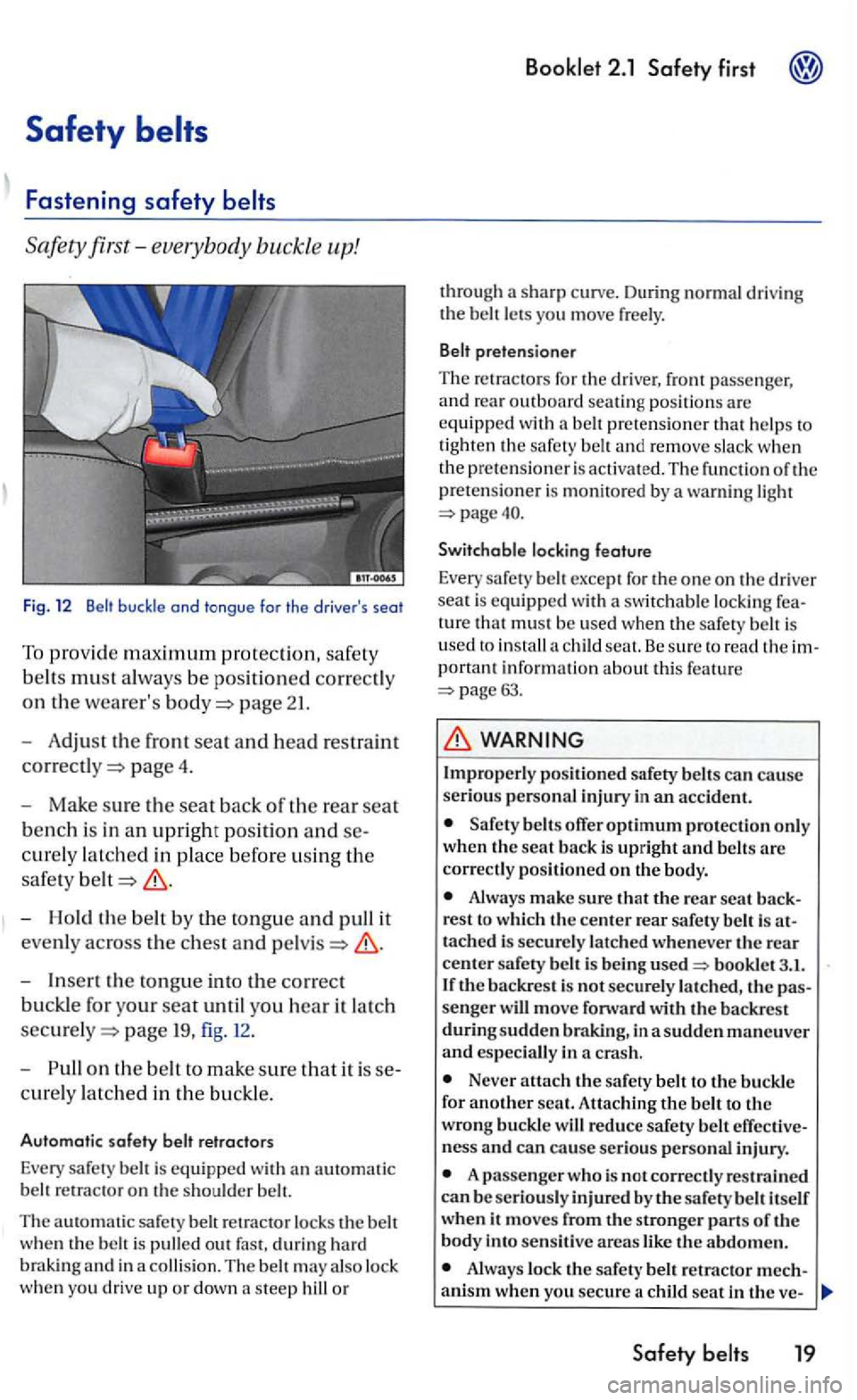
Safety
Safety first-everybody buckle up!
Fig. 12
page 2 1.
- A
djus t the front seat and head restra int
page 4.
-
Make sure the seat back of the rear seat
bench is in an upright position and
cure ly latched in place before using the
safe ty
belt
- Hold the belt b y the to ngue and pull it
eve
nly across the chest and
page 19, fig . 1 2.
-
o n th e belt to make sure that it is se
c u re ly latched in the buckl e.
Automatic safe ty belt retractors
Every safe ly is equi ppe d an o n he s houlder b ell.
The
s a fe ly belt r etrac tor lock s th e belt
w he n the belt is pulled out fast, durin g ha rd
brak ing and in a collision. The ma y also lock when you drive u p or d own a steep hill or
Booklet 2.1
through a sharp curv e. During normal drivin g
the
for the d river, fron t passenge r,
a nd rear out bo ard seating po sition s are equipped wit h a prete n sioner that h elp s to tig h ten the sa fe ty and remove slack w hen
th e pr ete n sioner is act iva te d. Th e functi on of th e
p retension er is monito re d b y a warning light
Switchable lockin g feature
Every safety exce pt for th e one on th e dri ver seat is equipped w ith a switchabl e lock ing ture that mus t be u se d w hen the sa fety is u se d to install a c hild seal. Be sure to read he portant informa tio n abou t thi s fea tur e page63.
WARNING
Improperly posi tion ed safety
offe r optimum protec tion only when the seat back is upright and belts are correctl y po sition ed on the body.
Alwa ys make sure that the rear seat back
r es t to whi ch th e center rear safety is at
tach ed is secu re ly latched whenever th e re ar
cente r safe ty belt is being used bookl et 3.1. If the bac kres t is not s ecurely la tc hed , the passenger wiU move forward with the backre st durin g sudden braking, in a sudden maneuver
and e specially in a cra sh .
Never att ac h the safet y belt to the buckle
for another scat. Atta chin g the belt to the wrong buckle w ill re du ce safety belt ness and can ca use serious perso nal injury.
A passenger who is not correctl y res tra ined can be se riou sly injured by the sa fety belt itself
w hen it moves from th e stronger parts of the body int o sensit ive areas like the abdomen.
Alwa ys lock th e safe ty belt re tra ctor m echanism when yo u secure a child seat in th e ve-
Safety belts 19
Page 122 of 444
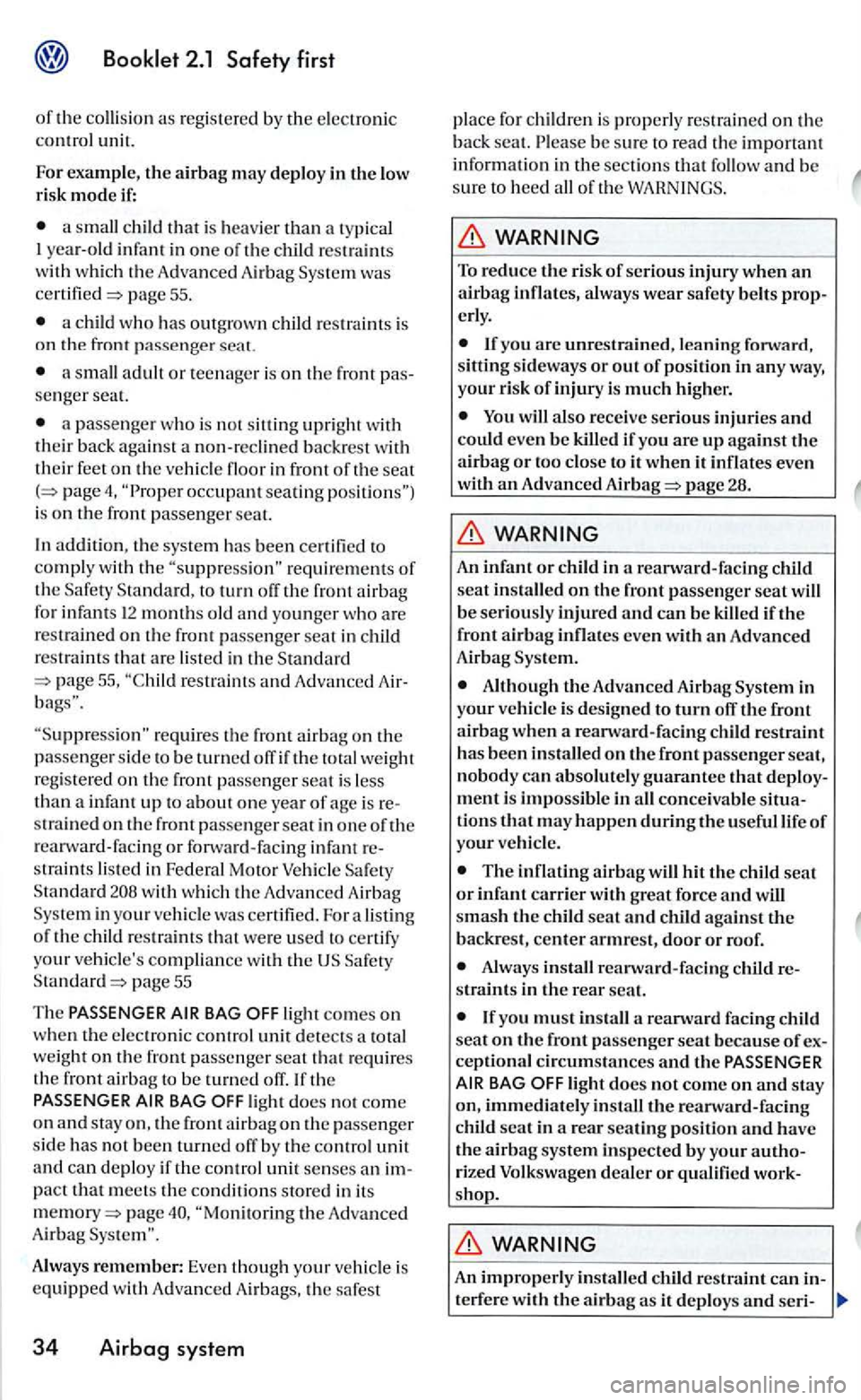
a small child that is heavier than a typica l
I ye ar-old infant in one o f th e child restraint s
w ith whi ch th e A dvan ced Airbag was page 55.
a child who has outgrown child res traints is
o n
a small adult or te enage r is on th e front se nger seat.
a passe nge r w ho is not sitting upright with
thei r back against a non -re clined backr est with
th eir feet on th e ve hicl e floor in front of the seat occupant seatin g is on t h e fr o nt passenger seat.
re quir em ent s of th e to turn off the fron t a irb ag
f o r infant s 12 months old and younger w ho are
re strained on the fro nt passenger seat in ch ild
restraint s that are liste d in the Standard re str aint s and Adva nce d
requires the front airb ag on th e passenge r sid e to be turned off if th e tota l weig ht
r eg is tered on th e front passe nger is less
th an a inf ant up to about one year of age is s tra ined on the front passe nger seat in one of the rea rward-faci ng or for wa rd-fa cin g inf ant str aint s listed in Fed eral Moto r Vehicle
page 55
The BAG
light does no t come o n and stay on . th e front airbag on the passen ge r
s id e has not been turned off by th e co ntrol u nit and can deploy if th e control unit se nses an pact that meets th e co nditio ns s tored in its page
Alwa ys remember: Even thoug h yo ur veh icle is equipp ed with Adva nced Airb ags, the sa fest
34 Airbag system
pla ce fo r childr en i s properl y restrained on th e back seat. b e sure to read the important
information in the sections tl1at follo w and be
sure to heed all of th e WARNINGS.
To reduce th e risk of serious injury when an airbag inflates , always wear safety belts erly .
You will also receive serious injuries and could even be killed if you are up against the airbag or too close to it when it infl ates eve n
with an Advance d Airbag
An infant or child in a rearward-facing child
seat installed on the fron t passenger seat will be seriously injure d and can be killed if th e
front airbag inflate s eve n with an Advanc ed
Airbag System.
Although
ment is impossibl e in all conce ivab le tions that may happen during th e usefu l lif e of your ve hicle.
The infl atin g airbag hit the child seat or infant ca rrier with great force and will
s m as h th e child seat and child against backres t, center armrest, door or roof.
straint s in the rear seat.
front passe nge r scat because of ceptional circumstances and the
sh op.
terfer e with the airbag as it deploys and seri -
Page 128 of 444
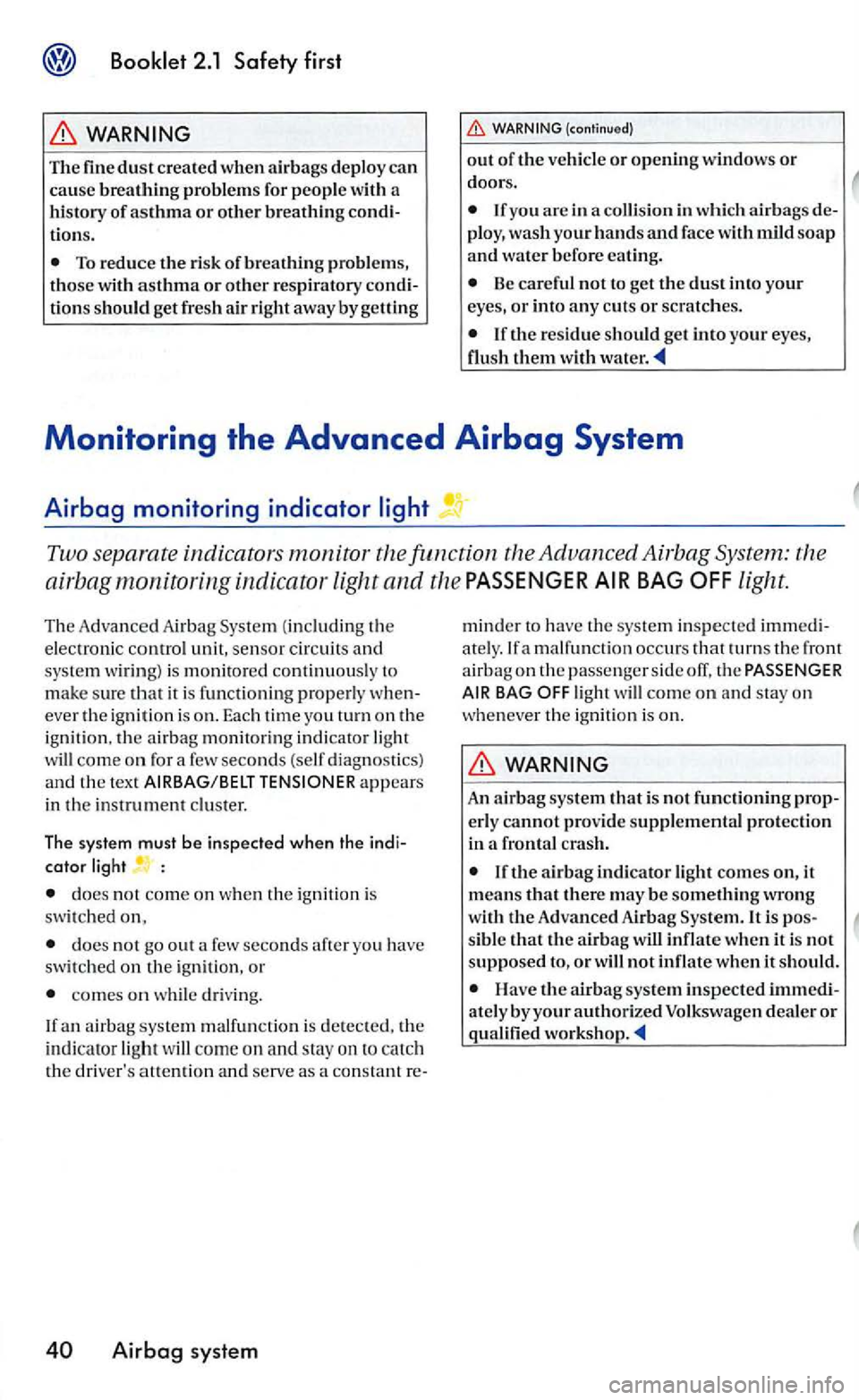
WARNING
The fine dust created when airbags deploy can cause breathing proble m s for people w ith a history of asthma or other breathing condi
tions.
To reduce the risk of breathing problems,
those with asthma or other respiratory condi
tions should get fresh air right away by getting
(cont;nu od)
out of the vehicle or opening w indows or doors.
If yo u are in a co llision in which airb ags de
ploy, wash your h ands and face with mild soap and water before eating.
Be carefu l not to get the dust into your eyes, or into any cut s or scratc hes.
If the residue should get into your eye s,
flush them with water.
Two separate indicators monitor the function the Advanced Airbag System: the
airbag monitoring indicator light
and the PASSENGER light.
The A dva nced Airba g Sys te m (in cludin g th e electronic control unit, senso r c ir c uits and sys te m wiring) is m onit ore d continuously to mak e sure tha t it is fun cti o nin g properl y wheneve r the ignition is o n. Each time you turn on th e
i gnition. the a irba g monitoring indicator light
w ill co me o n for a fe w second s (se lf di ag nostics) and th e text AIRBAG/BELT appears
in the in strument clu ster.
The sys tem must be inspected when the indi
cator light
does not come on when th e ignition is
switc h ed on,
doe s not go out a few seconds after you have
s wit ched on the ignition, or
comes o n while driving.
If an airbag system malfu nc tion is de te cte d , th e
indicator light will come on and sta y on to catch
th e dri ver's attention and se rve as a con stant re-
fa malfunction occurs that turn s th e front airbag on th e passe nge r side th e PASSENGER AIR BAG
WARNING
An airbag system that is no t functioning prop
erly cannot provide suppl emental protection
in a frontal crash.
not inflat e when it should.
Page 134 of 444
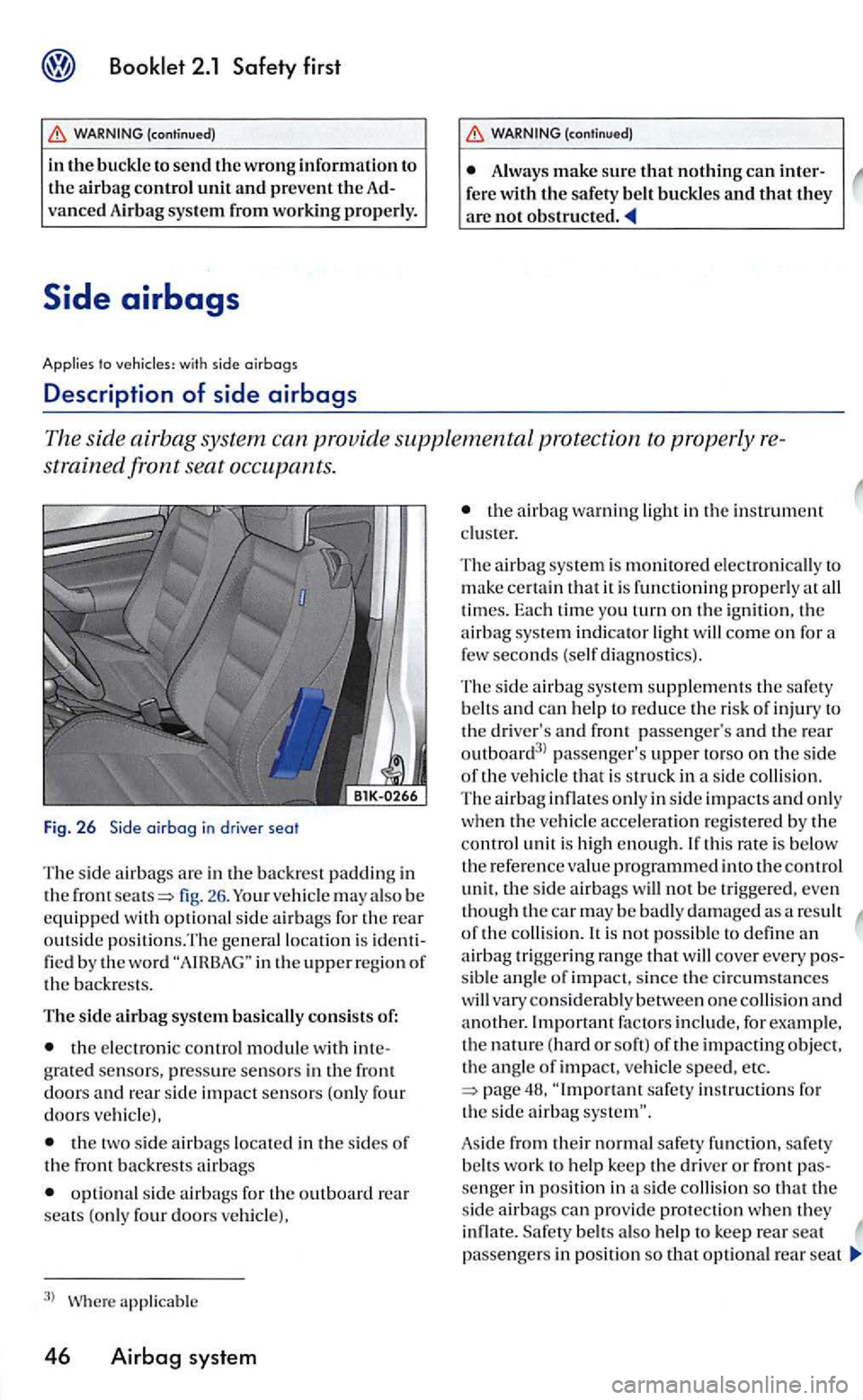
to vehic les: with side airbags
Description of side airbags
Always make sure that nothing can inter-fe re with the safety be lt buckles and that they are not
The sid e airbag system ca n provid e supplemental protection to properly
strain ed fron t seat occupant s.
Fig. 26 a irbag in drive r seat
The side air b ag s are in the backr est p addin g in the fig. 26 . ve hicl e m ay als o b e
equipped w ith optiona l sid e ai r bags for the re a r
outs id e po siti ons.Th e ge nera l lo cat io n is in the upper regio n of the backrests .
The side airbag system basically consis ts of:
the e lectroni c co ntro l module with grated sensors, pre ssure sen so rs in the front doors and re a r s ide impact sensors (only four doors ve hicle).
the two side airbags locate d in the s ides of the fro nt backre sts a ir ba gs
opti ona l s id e a irbags for the outboard rear seats (only four door s ve hicle).
3) W here ap plicabl e
46 Airbag system
the airbag warning light in the in strument clu ster.
The airb ag syste m is monitore d electroni cally to make certain that it is fun ctioning properly at all times. Ea ch time you turn on th e ig nition, the
a irba g syste m indi cator light will come on fo r a
few s e conds (self diagnostic s).
Th e side
airbag s ys te m supplements the s afet y
b elt s and can help to reduce the ris k of injury to the dri ver's and passenge r's and the rear
outboard3> passen ge r's upper to rs o on the s ide
o f the ve hicl e that is st ruck in a s ide colli sio n. The a irb ag infl ates onl y in sid e impacts and o nl y
w he n th e ve hicle accele rati on r egis te re d by the
co ntrol unit is hi gh enough. If thi s rate is be lo w
th e re fe re nce valu e progr ammed into the control unit. the s ide airb ags will not be tri gge re d , ev en
th oug h the car m ay be bad ly da m ag ed a s a re su lt
o f the c ollis ion .
sib le angle of impa c t, s ince th e c ircumsta nce s
will v ary consid era bly betw een one collisio n and ano ther. Important fac tor s includ e, Fo r e xample, the nature (hard or soft) oft h e impacting o bject, the ang le of impact, ve hicl e speed, e tc . s afe ty in stru ctions fo r the sid e a irbag
Aside from their normal safety function, sa fe ty
b elt s work to he lp keep the driver or front se n ge r in po sition in sid e co llision so that the
s ide airb ags c an pro vid e pro tection whe n th ey
inflate. Safety belt s als o help to keep rear seat
passenge rs in pos ition so tha t opti onal seat
Page 140 of 444
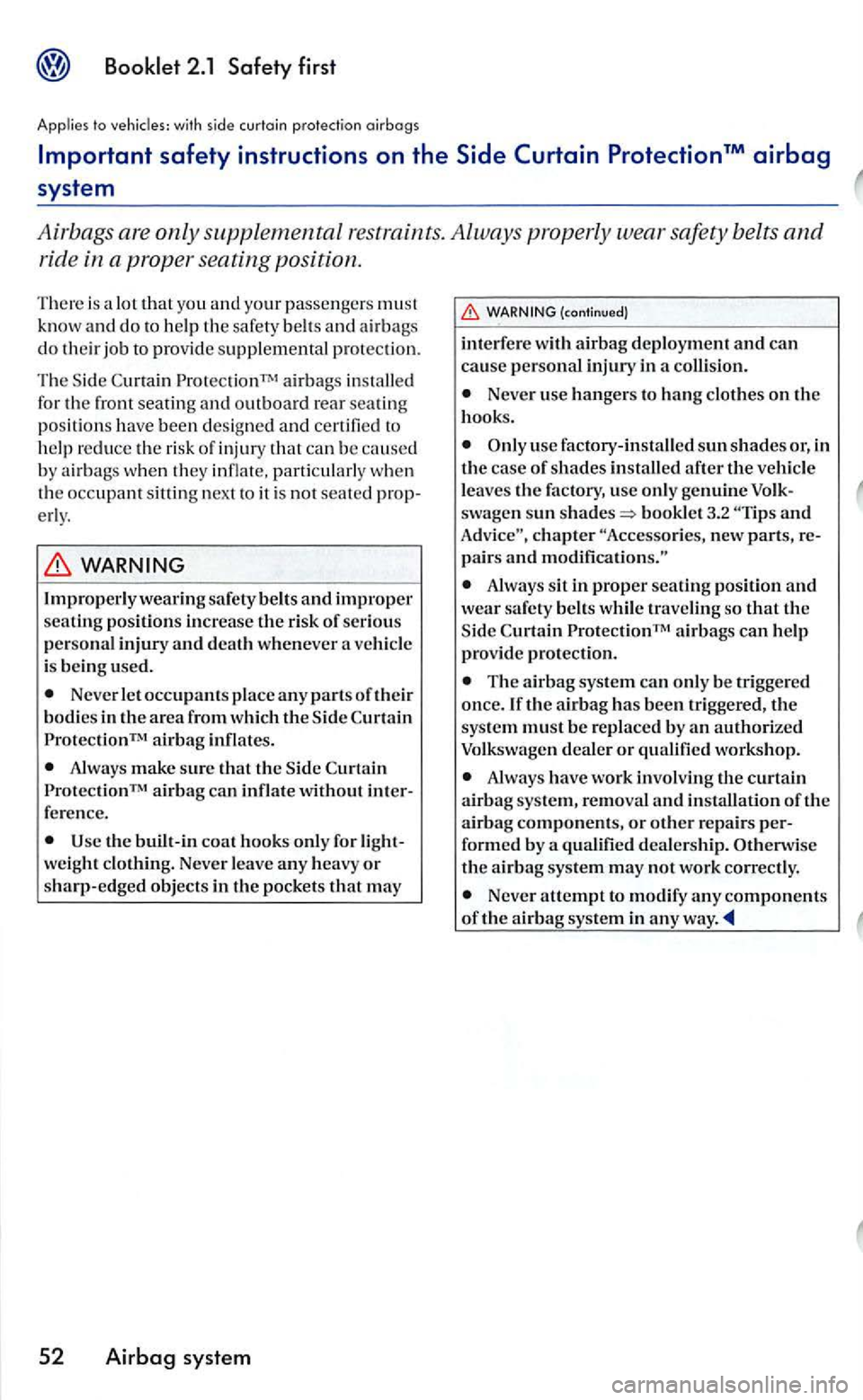
that you and your passenger s must
know and do to help the safety belt s and airbag s do their job to provide supplem ental protec tion .
Th e S
ide airb ags installed
for th e front seating and outboard rear seating
posit ions have been desig ned and ce rtified to he lp reduce the risk of injur y that can be caused
b y air bags when they inflate, particularly w he n
th e occupant sitti ng nex t to it is no t seated prop
erly .
WARNING
lmp roperlywearingsafcty belts and improper seating positions increase the risk of serio u s
p erso na l injury and death whenever a vehicle
i s being used.
Never let occupants place any parts of their bodi es in th e area from whi ch th e Side
Always make sure that th e S ide
Use the built-in coat hooks only for light
we ight clothing. Never leave any heavy or sharp-e d ge d object s in the pocket s th at may
52 Airbag sy ste m
(contin ued)
interf ere w ith airbag deployment and can
cause personal injury in a collision .
Never use hangers to hang clothe s on th e
h ooks.
use factory-installed sun shades in the case of shades installed after the vehicl e
l eaves the factory, use only genui ne swagen sun booklet 3.2 new parts, re
pair s an d modification s."
A lways sit in proper sea ting position and wear safety belts whil e trave ling so that th e
Side
The a irb ag sys te m can onl y be trigger ed
once. the airb ag has been tr iggered, the
system must be rep laced by a n authorized Volkswagen dealer or qualified workshop.
Always have work involv in g the curtai n
airbag system , removal and installation of the a irbag components, or other repairs per
formed by a qualified dealers hip. Othenvis e
the airbag system m ay no t work correctly.
Neve r attempt to modify an y components of the airbag system in any way
Page 143 of 444
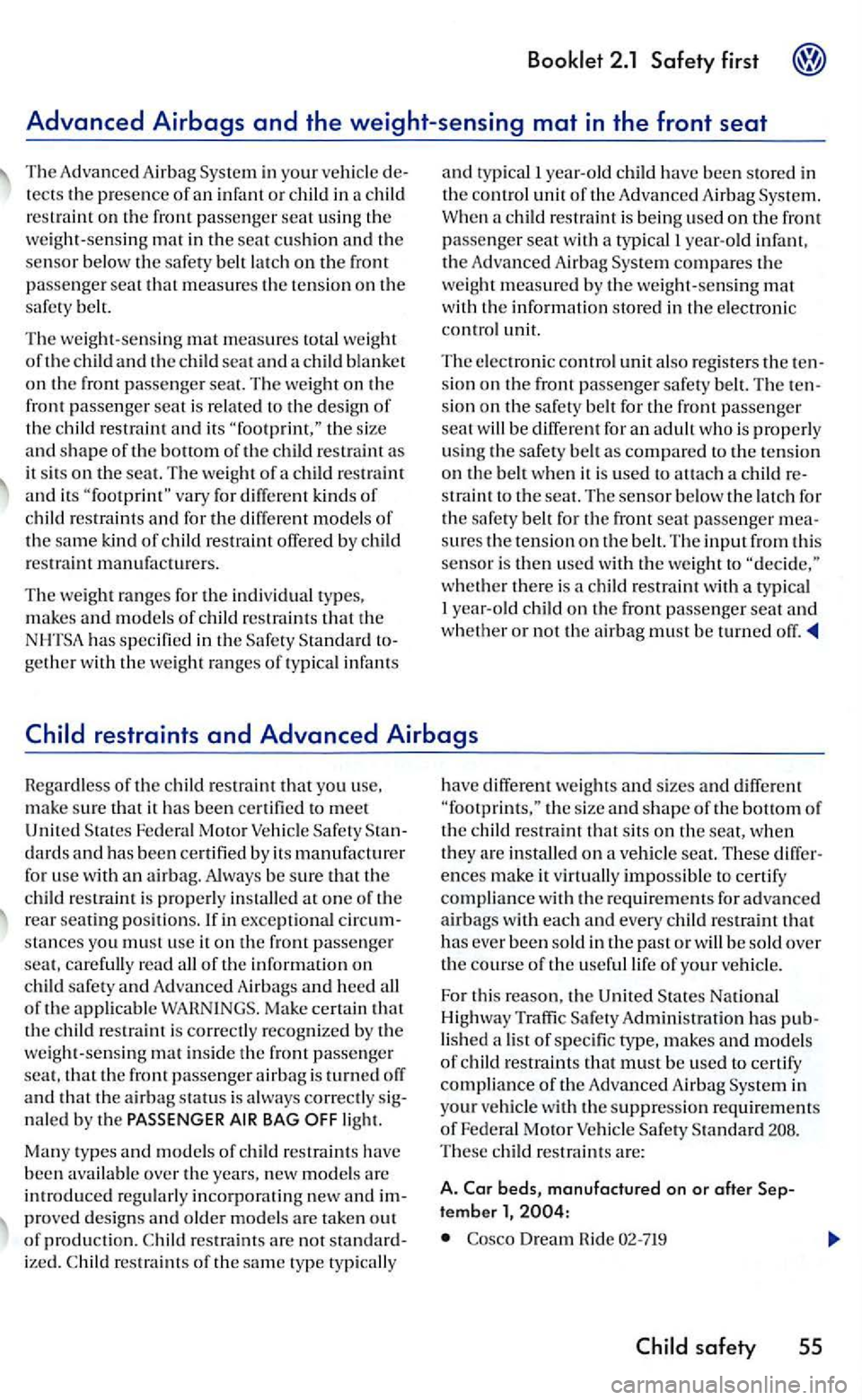
2.1 Safety first
child on the front passe nger seat u sing th e weight-sensing m at in the seat c ushion and the sen sor below the safety belt latch on the front
p assenger seat that measures th e tension on the safe ty be lt.
Th e we ight -sensin g
mat measures to tal weight of the c h ild and th e child seat and a chi ld blanket on th e front passeng er seat. The weight on the
front pas s enge r seat is re lated to the design of th e c hild restraint and its the size and s h ape of the bo ttom of the chil d restr aint as
it sit s on the seat. The w eight o f a child restraint and its
manufacturers .
T he
weight ra nges for the indi vidual types,
m akes and models of child restr aints that th e
N HTSA has s pecified in the Sa fe ty Standard gether w ith the weight r a n g es of t ypical infan ts a
nd ty
pical I year-old child have been in
th e control unit of the Adva nced Airba g Sys te m.
When a child restraint is being used on the front passenger seat w ith a typic al! year-o ld infant ,
th e Ad va nc ed Airbag System compares the weight measured by the weight-sensin g m at
with the informa ti on stored in the electro nic
control unit.
T he el
ectroni c control unit als o registers the s ion on th e front passenger safe ty belt. The sion on th e sa fe ty belt for the front passenge r
seat w ill be differe nt for an adult who is properly using the sa fety belt as compared to the te nsion on th e belt when it is used to atta ch a child strain t to the seat. Th e sensor below the latch for the sa fet y belt for th e front seat passenger sures the tension on th e belt. The input from this
se nsor is then u sed w ith the weight to w he th er there is a child restraint with a ty pical
I year-o ld child on the front passenger seat a nd
w hether o r n ot th e airba g must be turned off .
Safety dards and has been certified by its m anufa cturer
f o r use with an airbag. Alwa ys be sure that the chil d restraint is pro perly in stalled at one of th e
rear seating positi ons. If in exce ptional sta nces you must use it on the front passe nge r seat, carefully read all of the information on child safety and Ad vanced Airbag s and heed all of th e a pplic abl e WARNINGS. Ma ke certain that
t h e c hild res traint is correctly recognized by the
we ig ht-sensi ng mat in side the front passeng er seat, that th e fron t passenger a irb ag is turne d off and that the airbag statu s is alw ays correctly naled by the BAG light.
Man y ty
pes and model s of c hild restrain ts hav e
been availabl e ove r the years . new mode ls a re introduced reg ularly incorporating new and prove d desig n s and older mod els are take n out of production. res traint s are not iz ed. re s traint s of th e same type ty picall y h
ave diff e
rent weig hts and sizes and diff erent the size and s hape of the bottom of
th e child res traint that sit s on the seat, when they are in stalled on a seat. These ences make it virtu ally impossibl e to certify compliance with the require m ents for advanced
airbags with each and every child restraint that has ever been so ld in the past or w ill be s old ove r
t h e course of the useful life of your
For thi s rea son, the United States National High way Traffi c Sa fety Adm ini strat ion has lis h e d a list of s p ecific type, makes and m od els of c hild restraint s that must b e use d to certify compliance of th e Advanced Airbag System in
your ve hicle with the suppression requirements of Federal Mo tor These child restraints are :
A. Car beds, manufactured on or after tember 1,
Dream Ride 02-719
safety 55
Page 151 of 444
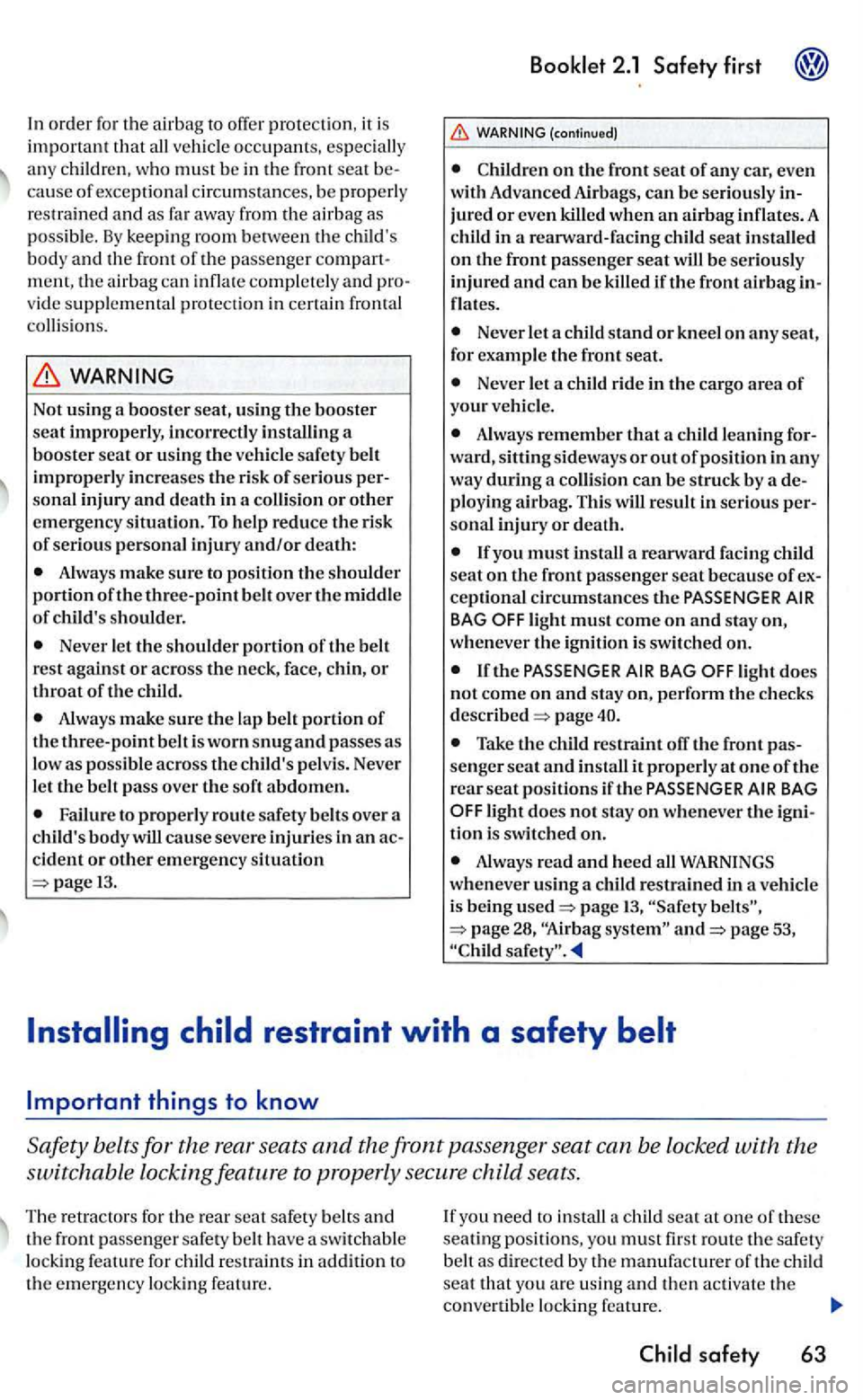
In order fo r th e air bag to otTer prote ction , it is
important that ve hicle occupants, es peciall y
a ny children , who must be in the front seat cau se of e xc e ptional circum stances , be prop erl y
r es trained and as far away from the airb ag as
possible. B y keep ing room be tween th e ch ild 's body and the front of the passe nger ment, the airbag can inflate complet ely and vid e supplemental protection in ce rtain frontal
c olli sions.
Not usi ng a booster seat, usin g the booster seat improperl y, incorrectly installing a booster seat or using the veh icle safe ty belt
improperly increases the risk of serious sonal injury and death in a or other em erg ency situation. To help reduce the risk of serio us personal injury and/or death:
Always make sure to position the shoulder portion of the three-point belt over the middle of child 's shoulder.
Neve r let the shoulder portion of the belt
res t against or across the neck, face, chin, or throat of the child.
Always make sure the lap belt portion of the three-point belt is worn snug and passes as low as possible across the child' s pelvis. Never
let the belt pass over the sof t abdomen.
Failure to properly route safety belts over a child's body will cause severe injuries in an
13.
(continued)
Childre n on the front seat of any car, eve n
with Advanced Airbags, can be seriously jured or even killed when an airbag inflates. A
child in a rearward-facing child seat in stalled on the front passenger seat will be seriously
injured and can b e killed if the front airbag flate s.
Never le t a child stand or kneel on any seat, for example the front seat.
Never let a child ride in the cargo area of your ve hicl e.
Always remember that a child leaning
ploying airbag. This will result in serio us sonal injury or death.
lig ht does not come on and stay on, perform the checks page
Take the child restraint off the front senger seat and AIR BAG light does not stay on whenever the tion is swi tc h ed on.
A lwa ys read and heed all WARNINGS w henever usin g a child restrained in a vehicl e
is being page 13, page 53,
safety 63